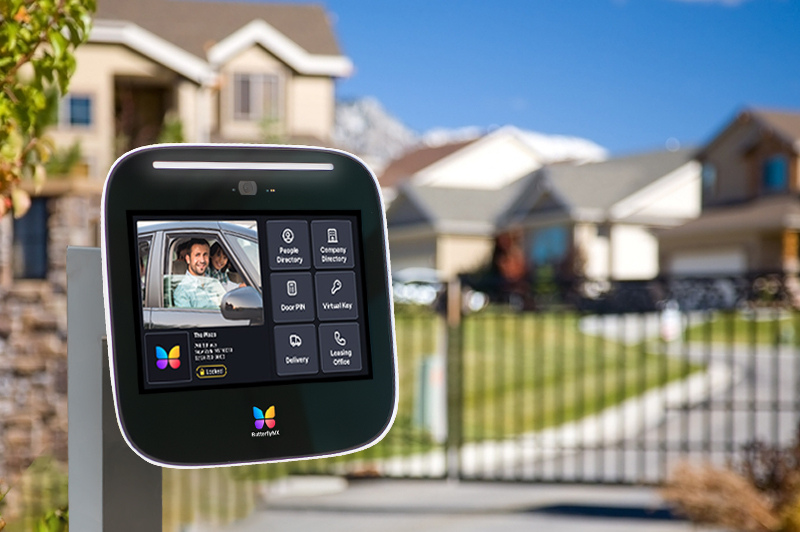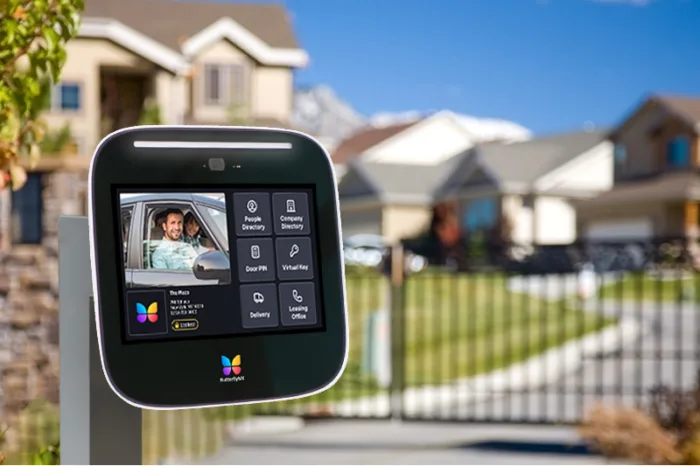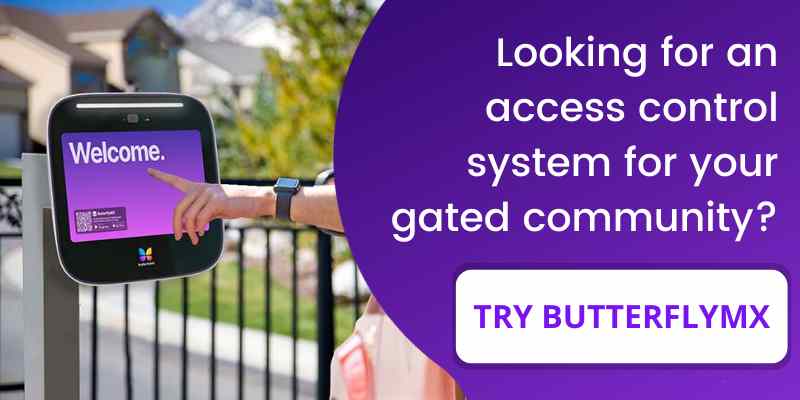Key takeaways
- Keyless gate entry is the future of gate access control.
- While there are some ways of implementing keyless gate entry with the help of a security guard, that’s not the most time- or cost-effective option. Instead, invest in a gate entry system powered by technology.
- More specifically, a gate that residents can open with their smartphones is the best keyless gate entry option. Such systems save time and money while providing residents with the safest and most convenient gate entry method.

If you manage security for a gated property, you have a lot of options — and a lot of responsibilities. Residents living in a gated property value security, and it’s your job to maintain top-notch security while ensuring that property access is still convenient for residents and their guests. So how can you accommodate both of those needs? One solution is installing a keyless gate entry system.
In this post, we explain what keyless gate entry is, what a keyless gate lock is, and how they work. Then, we go over the criteria for picking the best keyless gate entry system for your property.
This post covers:
- What’s the best keyless gate entry option?
- What is keyless gate entry?
- How does keyless gate entry work?
- How should you pick your keyless gate entry system?
What’s the best keyless gate entry option?
When you consider factors like security, convenience, and cost, the best keyless gate entry system is the ButterflyMX smart video intercom, which empowers residents to open the gate with their smartphones.
Here’s why ButterflyMX is the best keyless gate entry system:
Robust security features
The ButterflyMX gate entry system is entirely automated. So, a resident can open the door for themselves and their guests without help from security guards.
What’s more, the ButterflyMX intercom also takes a photo whenever the gate is opened. This creates an audit trail of all gate entries that your staff can review to increase security. As such, residents can rest assured that tailgating and other crimes will be addressed and prevented immediately.
Streamlined convenience for all
ButterflyMX is convenient for residents, visitors, and staff.
No one likes to sit in traffic. ButterflyMX speeds up the flow of traffic into gated properties by empowering residents to open gates without getting out of their cars or talking to a security guard. Residents simply swipe or tap the ButterflyMX app on their smart devices to open the gate.
Additionally, another one of ButterflyMX’s most powerful features is the Visitor Pass, which empowers residents to grant managed access to visitors. Visitor Passes are QR or PIN codes that residents can assign to trusted guests, such as service providers. Residents control the times and days their guests can enter the property, giving them peace of mind.
Watch how Visitor Passes work with ButterflyMX:
For staff, ButterflyMX’s cloud-based software and integrations with other proptech solutions will reduce administrative work. Such integrations ensure that changes reflected in your rent roll are automatically pushed out to the gate entry system’s database. Even better, the cloud-based technology allows staff to manage property access from anywhere. All this frees your staff from tedious manual work, allowing them to spend more time improving the resident experience.
Cost-effectiveness
Compared to a fully staffed gate security booth, ButterflyMX is undoubtedly the more cost-effective option.
But there’s more: ButterflyMX is a wireless gate intercom system that only needs two connections, power and internet. Compared to wired electronic gate systems, you’ll save on installation costs. With ButterflyMX, there’s no need to run expensive wiring throughout your property.
Plus, because ButterflyMX is a smartphone-based system, you’ll also save time and money on issuing credentials like fobs or cards.
What is keyless gate entry?
Keyless gate entry is a method of gate access control that lets a person enter a gated property without having to use an old-school brass key.
There are two primary ways a resident can enter a gate without using a key:
- A security guard checks credentials manually. The guard verifies the resident’s identity and lets them in.
- Using digital credentials — like a key card, a fob, a PIN code, or a smartphone — to verify access permissions to enter the property.
Either way, keyless gate entry renders the brass key a thing of the past.
Many properties find keyless gate entry convenient. For example, it allows multifamily properties to add another level of security for residents or commercial and industrial complexes to maintain high security. Because gated entrances are usually outdoors, these properties typically need a fully weatherproof keyless gate lock.
Keyless gate entry requires two components:
- Keyless credential reader. Keyless access control readers offer a digital way to confirm a person’s identity. In the past, property managers had to depend on analog options, like a button that summoned a security guard. However, today’s digital options are more efficient and don’t always require a person to be present.
- Electric gate. Keyless entry gate locks are electrically powered, allowing guards to grant access without having to manually open the gate. An electric type of security gate can also automate entry entirely when installed with a credential reader. That way, once the user’s credentials are verified, the reader activates the gate opening mechanism.
How does keyless gate entry work?
Keyless gate entry works by providing a way for residents to unlock a gate without a key. Depending on whether you’ve stationed a security guard at your gated entrance, keyless gate entry works in different ways.
The two most popular forms of keyless gate entry systems are:
Guard-based
Here are the steps to operating a guard-based gate system:
- Resident speaks to guard. On some properties, there’s a guard stationed right at the gate. In this case, the guard speaks with the resident right away. On other properties, a guard is stationed elsewhere, so the person requesting access must speak with the guard remotely using a call box.
- Guard verifies resident’s identity. A resident might not need to present a credential if a security guard depends solely on visual identification. However, in other cases, the guard takes the resident’s credential and inspects it to verify their identity.
- Guard opens gate. The guard presses a button that releases the keyless gate lock, allowing the resident to enter.
Credential-based
Here’s how a credential-based keyless system works:
- Resident presents credential. The resident presents their credential to a reader installed near the gated entrance. This step looks different depending on the type of credential you’ve assigned to residents. For example, a resident might punch in a PIN code on a keypad, or hold a key card up to a reader.
- Reader verifies credential. The reader scans the encrypted data on the credential to compare the information to what’s in the database. If the reader finds a match, it instructs the gate to open.
- Reader opens gate. After the keyless entry gate opens, the resident can enter.
How should you pick your keyless gate entry system?
As you’re aware, there are many different methods of keyless entry for outdoor gates. So: Which option will best secure your property while saving you money? Here’s how you can tell which keyless gate entry system is the best.
When you’re choosing your keyless entry system, look for these three characteristics:
1. Cost-effective 24-hour operation
Residents expect a security gate to protect their community at all times, both day and night.
Here’s where depending on an entirely human-powered security system fails to be cost-effective. It’s true that you could hire a system of guards that rotates out so the gate is always staffed.
However, third-shift guards working the graveyard hours don’t usually let a lot of guests in. And they can cost you thousands of dollars a year.
Instead, with the help of technology, you could guarantee 24-hour coverage while freeing up your staff to focus on other aspects of security, like patrolling the property. For instance, a wireless gate access control system provides your property with cost-effective and robust security 24/7.
2. Cloud-based
After considering how to provide 24-hour coverage, you’ve learned that the most cost-effective options depend on technology and automation. But how do you manage a tech-powered gate entry system? Also, what’s the easiest way to add or remove residents from the system or edit access permissions for existing residents?
The answer: Cloud-based software.
A keyless gate entry system that requires a staff member to go on-site to update the tenant directory or adjust access permissions isn’t worth your money.
Instead, choose a cloud-based keyless entry system that lets staff make changes from any laptop or smartphone. That way, you can ensure that resident permissions are always up to date, even when staff is offsite. Plus, this will reduce wait times for residents getting through the gate.
3. Users can open the gate with their smartphones
You can choose from a variety of credentials to assign your residents. Many property managers hand out fobs, key cards, or PIN numbers.
However, each of those credentials comes with the same danger: your resident may forget to bring their credential with them — or worse, lose it.
As a result, your staff will need to physically open the gate for them or constantly issue new credentials.
But when’s the last time a resident forgot their smartphone? Probably never, or very rarely.
Eliminate the costs of constantly assigning and replacing credentials by installing a gate entry system that residents can control with their smartphones. And the best gate entry systems let residents access many other features on a smartphone app, like the ability to swipe to open the gate or issue Visitor Passes to their guests.






